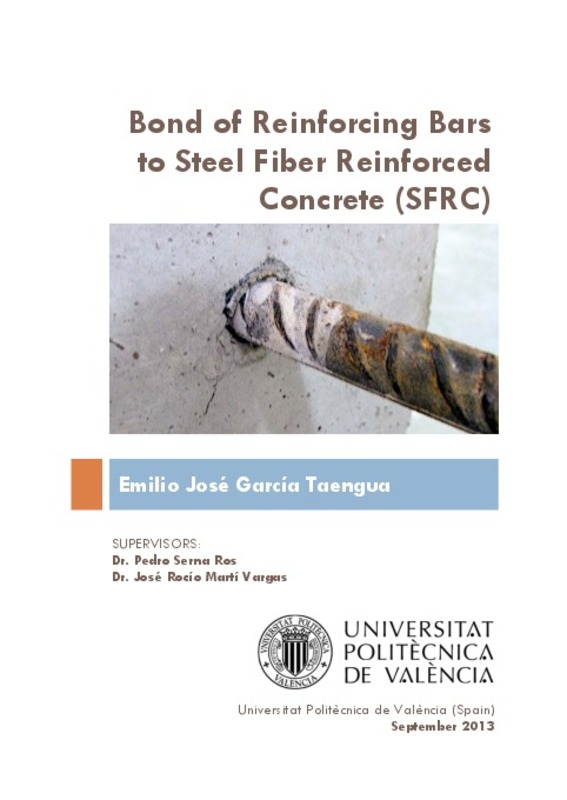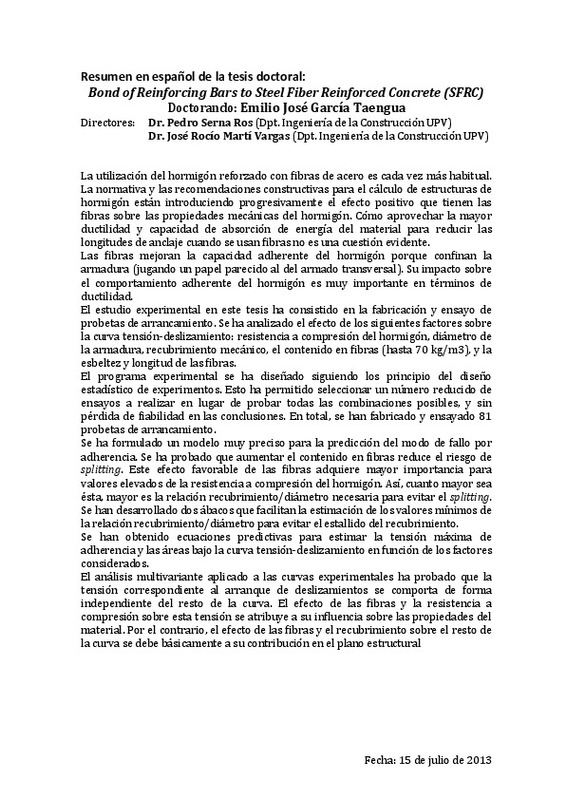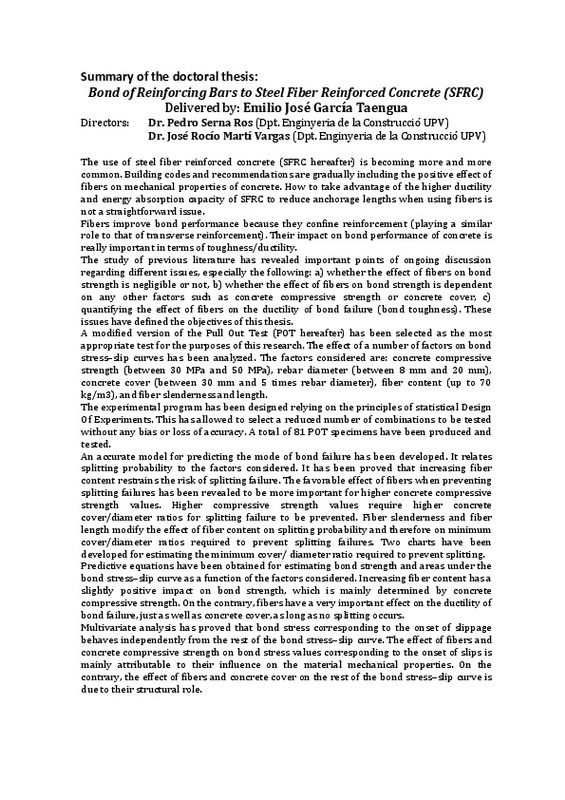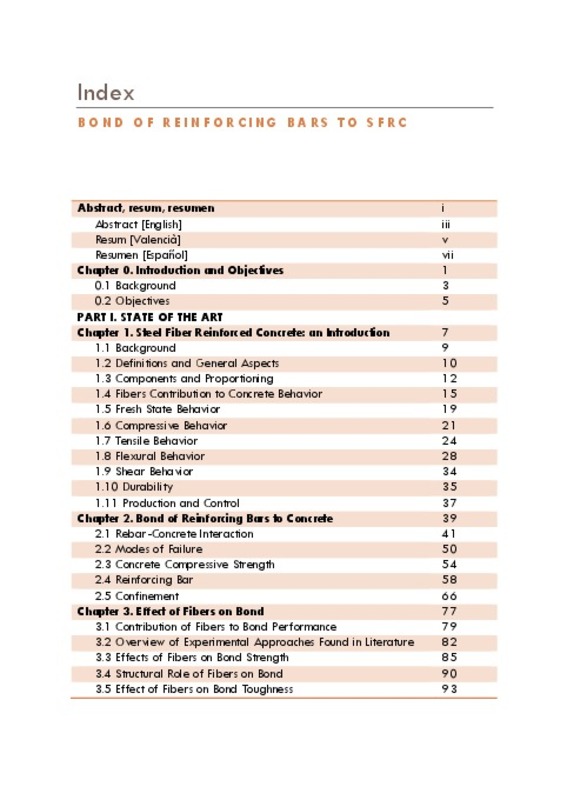- RiuNet repositorio UPV
- :
- Investigación
- :
- Tesis doctorales
- :
- Ver ítem
JavaScript is disabled for your browser. Some features of this site may not work without it.
Buscar en RiuNet
Listar
Mi cuenta
Estadísticas
Ayuda RiuNet
Admin. UPV
Bond of Reinforcing Bars to Steel Fiber Reinforced Concrete (SFRC)
Mostrar el registro sencillo del ítem
Ficheros en el ítem
| dc.contributor.advisor | Martí Vargas, José Rocío
|
es_ES |
| dc.contributor.advisor | Serna Ros, Pedro
|
es_ES |
| dc.contributor.author | García Taengua, Emilio José
|
es_ES |
| dc.date.accessioned | 2013-10-21T06:12:57Z | |
| dc.date.available | 2013-10-21T06:12:57Z | |
| dc.date.created | 2013-09-30T09:00:47Z | es_ES |
| dc.date.issued | 2013-10-21T06:12:53Z | es_ES |
| dc.identifier.uri | http://hdl.handle.net/10251/32952 | |
| dc.description.abstract | The use of steel fiber reinforced concrete (SFRC hereafter) is becoming more and more common. Building codes and recommendations are gradually including the positive effect of fibers on mechanical properties of concrete. How to take advantage of the higher ductility and energy absorption capacity of SFRC to reduce anchorage lengths when using fibers is not a straightforward issue. Fibers improve bond performance because they confine reinforcement (playing a similar role to that of transverse reinforcement). Their impact on bond performance of concrete is really important in terms of toughness/ductility. The study of previous literature has revealed important points of ongoing discussion regarding different issues, especially the following: a) whether the effect of fibers on bond strength is negligible or not, b) whether the effect of fibers on bond strength is dependent on any other factors such as concrete compressive strength or concrete cover, c) quantifying the effect of fibers on the ductility of bond failure (bond toughness). These issues have defined the objectives of this thesis. A modified version of the Pull Out Test (POT hereafter) has been selected as the most appropriate test for the purposes of this research. The effect of a number of factors on bond stress¿slip curves has been analyzed. The factors considered are: concrete compressive strength (between 30 MPa and 50 MPa), rebar diameter (between 8 mm and 20 mm), concrete cover (between 30 mm and 5 times rebar diameter), fiber content (up to 70 kg/m3), and fiber slenderness and length. The experimental program has been designed relying on the principles of statistical Design Of Experiments. This has allowed to select a reduced number of combinations to be tested without any bias or loss of accuracy. A total of 81 POT specimens have been produced and tested. An accurate model for predicting the mode of bond failure has been developed. It relates splitting probability to the factors considered. It has been proved that increasing fiber content restrains the risk of splitting failure. The favorable effect of fibers when preventing splitting failures has been revealed to be more important for higher concrete compressive strength values. Higher compressive strength values require higher concrete cover/diameter ratios for splitting failure to be prevented. Fiber slenderness and fiber length modify the effect of fiber content on splitting probability and therefore on minimum cover/diameter ratios required to prevent splitting failures. Two charts have been developed for estimating the minimum cover/ diameter ratio required to prevent splitting. Predictive equations have been obtained for estimating bond strength and areas under the bond stress¿slip curve as a function of the factors considered. Increasing fiber content has a slightly positive impact on bond strength, which is mainly determined by concrete compressive strength. On the contrary, fibers have a very important effect on the ductility of bond failure, just as well as concrete cover, as long as no splitting occurs. Multivariate analysis has proved that bond stress corresponding to the onset of slippage behaves independently from the rest of the bond stress¿slip curve. The effect of fibers and concrete compressive strength on bond stress values corresponding to the onset of slips is mainly attributable to their influence on the material mechanical properties. On the contrary, the effect of fibers and concrete cover on the rest of the bond stress¿slip curve is due to their structural role. | en_EN |
| dc.language | Inglés | es_ES |
| dc.publisher | Universitat Politècnica de València | es_ES |
| dc.rights | Reserva de todos los derechos | es_ES |
| dc.source | Riunet | es_ES |
| dc.subject | Bond | es_ES |
| dc.subject | Reinforcement | es_ES |
| dc.subject | Steel fibers | es_ES |
| dc.subject | SFRC | es_ES |
| dc.subject.classification | INGENIERIA DE LA CONSTRUCCION | es_ES |
| dc.title | Bond of Reinforcing Bars to Steel Fiber Reinforced Concrete (SFRC) | |
| dc.type | Tesis doctoral | es_ES |
| dc.identifier.doi | 10.4995/Thesis/10251/32952 | es_ES |
| dc.rights.accessRights | Abierto | es_ES |
| dc.contributor.affiliation | Universitat Politècnica de València. Departamento de Ingeniería de la Construcción y de Proyectos de Ingeniería Civil - Departament d'Enginyeria de la Construcció i de Projectes d'Enginyeria Civil | es_ES |
| dc.description.bibliographicCitation | García Taengua, EJ. (2013). Bond of Reinforcing Bars to Steel Fiber Reinforced Concrete (SFRC) [Tesis doctoral]. Universitat Politècnica de València. https://doi.org/10.4995/Thesis/10251/32952 | es_ES |
| dc.description.accrualMethod | TESIS | es_ES |
| dc.type.version | info:eu-repo/semantics/acceptedVersion | es_ES |
| dc.relation.tesis | 7322 | es_ES |
Este ítem aparece en la(s) siguiente(s) colección(ones)
-
Tesis doctorales [5389]












